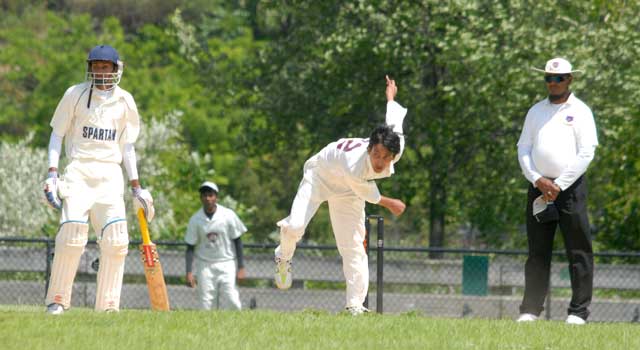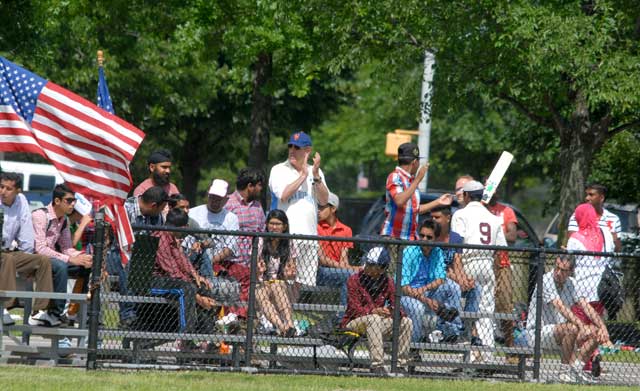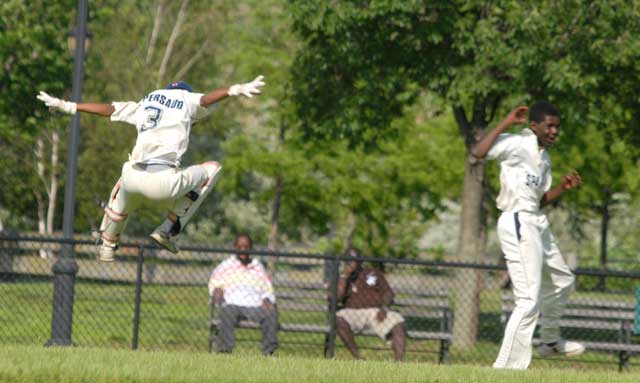Successful PSAL Cricket Heads Into Its Eleventh Season
New YorkNewsSam Soopersaud February 9, 2018 admin

2014 PSAL cricket final between John Adams and Hillcrest. Photos by Shiek Mohamed
By Sam Sooppersaud
There is a saying that goes like this: “It’s better late than never.” If someone plans to embark on a task, but because of extenuating circumstances that person finds himself not able to do so, then when he has the time he should try to accomplish his goal. This, so rightly applies to me. Since the end of the 2017 New York Public Schools Athletic League (PSAL) cricket season, I had planned to do an article on the ten years of the tournament. But it is only now that I am able to sit at my laptop and do this short piece.
Firstly, let me extend heartiest congratulations to the main administrators of the PSAL cricket program: Cricket Coordinator Lorna Austin, Cricket Commissioner Bassett Thompson and Assistant Cricket Commissioner Ricky Kissoon. These folks have worked so diligently and assiduously to ensure that the program is a resounding success. I unequivocally say that the program is a “success.” Kudos must also go to the rest of the staff who worked behind the scenes, to pull off the program, year after year.
The PSAL Varsity Co-ed cricket program commenced in 2008. In less than a month from now, on March 1st, a new season starts. It’s the 11th year of PSAL cricket. Last year thirty High schools participated in the three-month program: New York City Department of Education High schools in the Bronx, Manhattan, Brooklyn, and Queens. Schools in Staten Island were not in the tournament. The majority of the over 200 games are played after school is dismissed during the week. Some games are scheduled for Saturdays. I guess that traveling time is a consideration for not having the Staten Island schools involved at this time.
During the first 10 years of the tournament, six schools have shared the championships – Newcomers (2), Long Island City (2), John Adams (2), Richmond Hill (2), FDR (1) and William Bryant (1). With each succeeding season, the cricket has become more exciting, more competitive and boasts an increased fan base. At times, you will find hundreds of fans flocking the cricket parks in Queens, Brooklyn and the Bronx, enjoying exciting Twenty20 cricket, played by the young cricket stars of the future.
Being a former teacher I can’t help but equate performance in terms of a grade. Consequently, I will give a grade to various portions associated with the program. Administration: Scheduling B, Hands-on B, Processes C, Seeing to Field Readiness C. Umpiring C. Let us look at scheduling. To begin with 12 games per school are too many. A 10-game schedule is more in tune. We should realize that most of the games are played after school is dismissed. And players do not get home until after 9:00 p.m., at the conclusion of games. They are students and they need time to do their homework. They need to get an adequate amount of sleep.
We sometimes find that a school is playing three matches in one week. This is very disruptive to the student’s study program. In terms of cancelled games, in all cricket tournaments, once a game is rained out it is considered finished, completed, and gone.
But, in the PSAL cricket tournament rained out games are rescheduled. This puts an added burden on everyone: the players, the coaches, the administrators of the program, and the umpires. There are other factors that are also affected. But I think I have made it clear here that rained-out games should not be rescheduled. I should point out however, that I have brought up this problem with the folks at PSAL. Their answer is they want the kids to play as many games as possible. I feel that the real reason is, “More games, bigger budgets.” What is the now familiar saying? “Follow the money.”

Some fans the 2014 PSAL cricket final.
Hands-on by administrators: Numerous times there are officials at the games, who refuse to “interfere” when there are blatant abuses of the rules of cricket. Many times this occurs when umpires misinterpret or completely disregard the rules of the game. I know of several instances where umpires “consulted” after a decision was made by the ruling umpire, disregarding the time constraints that they must adhere to. To paraphrase the rule with regard to consultation by the umpires: This MUST be done in a timely manner. In international cricket, Decision Review System (DRS) allows 15 seconds for a player to ask for a review of a decision. Let our umpires make this the time constraint to be adhered to. In international cricket there is DRS, there is also a match referee. Let the cricket administrators at the park “be the DRS” when a rule is blatantly misapplied or not applied by the umpires.
Processes: There should be an independent committee, apart from the PSAL cricket administrators, to arbitrate various issues that come out time and again. Protests, umpiring issues, players employing illegal tactics, for instance a bowler “throwing” the ball. I feel that the committee should be comprised of participants in the program: administrators, coaches, school officials. I am quite sure that there are enough qualified persons associated with the cricket program that would be most willing to sit on such a committee.
Readiness of fields: Many times games are set at fields where the general condition of the field is not conducive for a cricket match to be played. All the coaches will tell you that Kissena’s #1 field is atrocious. To begin, there is a ditch within fifty feet behind the wicket on the northern side of the ground. When rain falls and that ditch is flooded it is a task to retrieve a cricket ball hit in the ditch without the players getting wet and muddy. This is like playing cricket at the edge of a pond. At Baisley Park North, The Cage, most of the time the grass is so long that it is like having added fielders on the field. I have seen fielders experiencing problems locating the ball in the tall grass.
Umpiring: I must say that most of the umpires do a very good job. But, I am sad to say, that some do a lousy job. They misinterpret the rules, or completely disregard certain rules. Their signals cause one to guess as to what play the umpire in trying to call. For instance, in calling a No Ball, I have seen some umpires raise a hand half way between the horizontal (No-Ball) and the vertical. (Bye). Of course, if the ball is played by the batsman or taken by the ‘keeper, one may conclude that the signal is a No Ball. But what happens if the ball is not played or not collected by the ‘keeper. Is the signal a No Ball or a Bye? This is only one example that some umpires need to do some more work on their game. I have seen a decision made by the ruling umpire negated by the other umpire. For instance, the ruling umpire signaled a boundary. After being questioned by the players, the square-leg umpire negated the ruling umpire’s decision, WITHOUT even consulting him.

On the plus side, I will say that the PSAL cricket program has contributed immensely to cricket in the USA. Numerous former players have gone on to represent the USA in international tournaments. Numerous players are playing in the senior cricket leagues around the New York area. They are doing a fantastic job on the cricket field. The program is accomplishing one of its goals of “getting kids together.” I am also a coach in the PSAL program. and one of my players once remarked to me, “Coach we may not be winning, but I am making lots of friends from the other teams.”
The eleventh year of PSAL cricket starts in three weeks. Athletic directors, coaches and players are already making plans for their schools. I know that the folks at PSAL have done tremendous work in preparing for the season. The schedule is already posted on the PSAL website. Many coaches are visiting the cricket stores selecting suitable equipment: balls, bats, pads, batting gloves and all other needed accouterments. I know of several fans that have said they can’t wait for the season to start.
Good luck to all!



